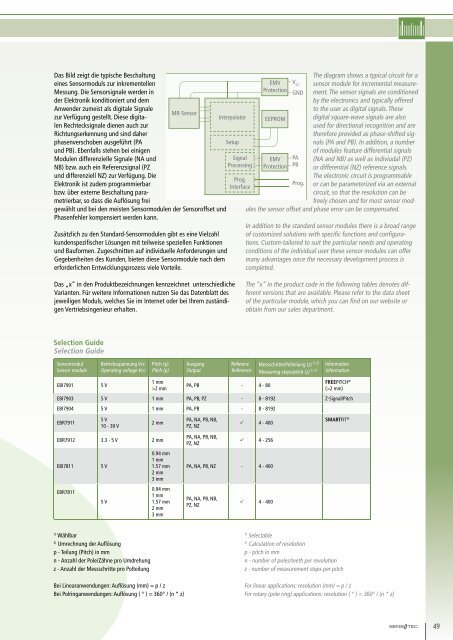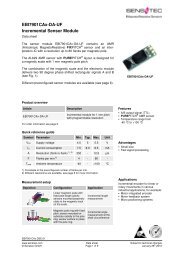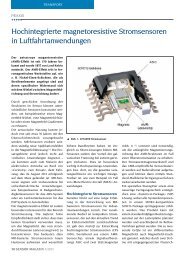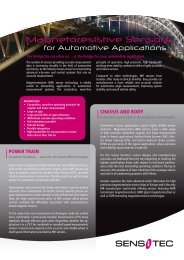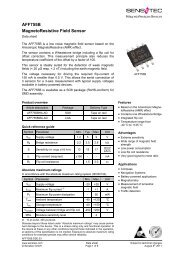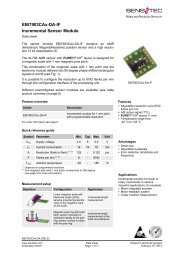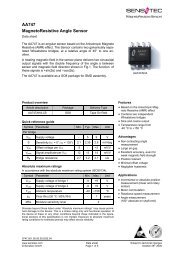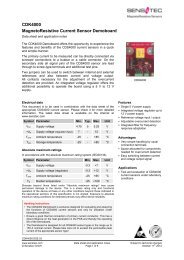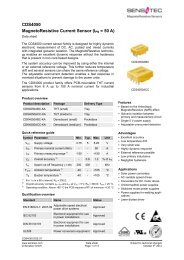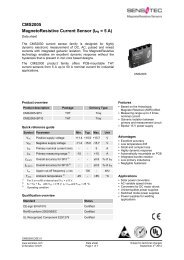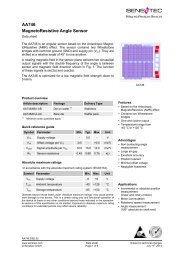WILLKOMMEN IM SENSOR KOSMOS WELCOME TO THE SENSOR COSMOS
WILLKOMMEN IM SENSOR KOSMOS WELCOME TO ... - Sensitec
WILLKOMMEN IM SENSOR KOSMOS WELCOME TO ... - Sensitec
- No tags were found...
Create successful ePaper yourself
Turn your PDF publications into a flip-book with our unique Google optimized e-Paper software.
Das Bild zeigt die typische Beschaltungeines Sensormoduls zur inkrementellenMessung. Die Sensorsignale werden inder Elektronik konditioniert und demAnwender zumeist als digitale Signalezur Verfügung gestellt. Diese digitalenRechtecksignale dienen auch zurRichtungserkennung und sind daherphasenverschoben ausgeführt (PAund PB). Ebenfalls stehen bei einigenModulen differenzielle Signale (NA undNB) bzw. auch ein Referenzsignal (PZund differenziell NZ) zur Verfügung. DieElektronik ist zudem programmierbarbzw. über externe Beschaltung parametrierbar,so dass die Auflösung freiMR-Sensorgewählt und bei den meisten Sensormodulen der Sensoroffset undPhasenfehler kompensiert werden kann.Zusätzlich zu den Standard-Sensormodulen gibt es eine Vielzahlkundenspezifischer Lösungen mit teilweise speziellen Funktionenund Bauformen. Zugeschnitten auf individuelle Anforderungen undGegebenheiten des Kunden, bieten diese Sensormodule nach demerforderlichen Entwicklungsprozess viele Vorteile.InterpolatorSetupSignalProcessingProg.InterfaceEMVProtectionEEPROMV CCGNDThe diagram shows a typical circuit for asensor module for incremental measurement.The sensor signals are conditionedby the electronics and typically offeredto the user as digital signals. Thesedigital square-wave signals are alsoused for directional recognition and aretherefore provided as phase-shifted signals(PA and PB). In addition, a numberof modules feature differential signalsEMV PA (NA and NB) as well as indiviudal (PZ)Protection PBor differential (NZ) reference signals.The electronic circuit is programmableProg. or can be parameterized via an externalcircuit, so that the resolution can befreely chosen and for most sensor modulesthe sensor offset and phase error can be compensated.In addition to the standard sensor modules there is a broad rangeof customized solutions with specific functions and configurations.Custom-tailored to suit the particular needs and operatingconditions of the individual user these sensor modules can offermany advantages once the necessary development process iscompleted.Das „x“ in den Produktbezeichnungen kennzeichnet unterschiedlicheVarianten. Für weitere Informationen nutzen Sie das Datenblatt desjeweiligen Moduls, welches Sie im Internet oder bei Ihrem zuständigenVertriebsingenieur erhalten.The “x” in the product code in the following tables denotes differentversions that are available. Please refer to the data sheetof the particular module, which you can find on our website orobtain from our sales department.Selection GuideSelection GuideSensormodulSensor moduleEBI7901Betriebsspannung VccOperating voltage Vcc5 VPitch (p)Pitch (p)1 mm>2 mmAusgangOutputReferenzReferencePA, PB - 4 - 801) 2)Messschritte/Polteilung (z) Information1) 2)Measuring steps/pitch (z)InformationFREEPITCH ®(>2 mm)EBI7903 5 V 1 mm PA, PB, PZ - 8 - 8192 Z-Signal/PitchEBI7904 5 V 1 mm PA, PB - 8 - 8192EBR79115 V10 - 30 V2 mmPA, NA, PB, NB,PZ, NZ 4 - 400SMARTFIT ®EBR7912 3.3 - 5 V 2 mmEBI7811EBR78115 V5 V0.94 mm1 mm1.57 mm2 mm3 mm0.94 mm1 mm1.57 mm2 mm3 mmPA, NA, PB, NB,PZ, NZ 4 - 256PA, NA, PB, NZ - 4 - 400PA, NA, PB, NB,PZ, NZ 4 - 4001)Wählbar2)Umrechnung der Auflösungp - Teilung (Pitch) in mmn - Anzahl der Pole/Zähne pro Umdrehungz - Anzahl der Messschritte pro Polteilung1)Selectable2)Calculation of resolutionp - pitch in mmn - number of poles/teeth per revolutionz - number of measurement steps per pitchBei Linearanwendungen: Auflösung (mm) = p / zBei Polringanwendungen: Auflösung ( ° ) = 360° / (n * z)For linear applications: resolution (mm) = p / zFor rotary (pole ring) applications: resolution ( ° ) = 360° / (n * z)49


